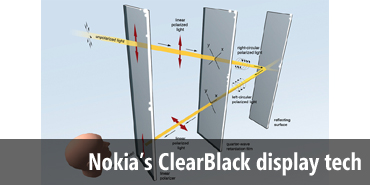As you may have gathered, I’m quite pleased with my Nokia Lumia 800. Being a geek at heart, I’m always keen to understand the technology under the covers so I was intrigued by a recent post by Ian Delaney at Nokia on their ClearBlack display technology that is employed in the Lumia.
He begins by extolling the virtues of bright, touch-driven displays and how they’ve changed our mobile world – but in the quest to beat the sunshine reflecting on those displays, Nokia has sought to find a balance that gives you a better reading experience but doesn’t simply amp up the brightness at the cost of battery life. Hence, the ClearBlack display which uses a sequence of polarizing layers to eliminate reflections. My Oakley shades are polarized and work in a similar fashion, reducing reflections and glare, but the ClearBlack technology is more detailed than my Oakley’s as the light rays are processed many times on their way in and out of my Lumia’s screen. As Ian notes:
There’s both a linear polarizer and retardation layers between the surface of your phone and the display. When light hits your screen, this is what happens:
- It hits the linear polarizer, this vertically polarizes the light. (Polarizing means – roughly – aligning the wave vibration in a particular direction).
- Then it hits the circular polarizer retardation layer. This converts the light again, making it right-circularly polarized.
- Then it hits the screen and bounces off it, switching the rotation of the light to leftist.
- It goes back through the retardation layer. When this happens, the light becomes horizontally polarized.
- Finally, it hits the linear polarizer, since the light is horizontally polarized at this point it can be blocked entirely by this optical solution
The obvious question is how does the light from the phone display make its way through all of this? Ian answers that part too…
Because it only goes through the second half of this journey so the light is unpolarized when it hits the final filter and goes through.
Neat…here endeth today’s geek lesson.





